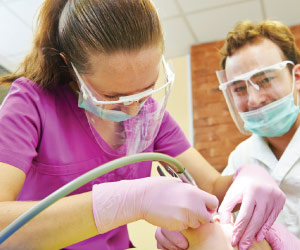Sedation Dentistry For Kids
Helping Children Overcome Fear and Anxiety
Dear Doctor,
My 10-year-old has multiple cavities that need treating, and he’s really anxious despite the best efforts of our dentist. What can be done to make the necessary treatment as easy as possible for him?

Dear Samantha,
Advances in sedation drug therapy have enabled many pediatric healthcare providers to treat children and teenagers who would otherwise be too anxious and fearful. Many dental professionals who treat kids are now performing more invasive procedures, such as filling cavities or extracting teeth, in conjunction with conscious sedation. This is a type of sedation in which the child feels completely calm and relaxed but can still breathe normally on his or her own and respond to certain stimuli. General anesthesia by contrast is the total loss of consciousness, and is therefore not considered conscious sedation.
Conscious sedation can achieve a minimal, moderate, or even deep suppression of consciousness — after which the child will remember nothing about the procedure. Minimal conscious sedation is the most commonly used for the treatment of fear and anxiety with invasive dental procedures. It allows the child to retain the ability to breathe independently and respond appropriately and normally to physical tactile stimulation and verbal commands. Minimal (which can progress to moderate) conscious sedation is commonly achieved with medication taken by mouth (orally). Deep conscious sedation usually relies on the use of sedative medication delivered through a vein (intravenously). All of the above can be administered in an office setting by a dentist who is specially trained and qualified in dental sedation.
Because reducing fear and anxiety is not the same as preventing pain, minimal or moderate oral conscious sedation is often accompanied by a nitrous oxide/oxygen combination, which when inhaled produces some pain relief; this is used with a local anesthetic delivered by injection. If your child is to be sedated at the dental office, you will typically be instructed to feed him a low-fat dinner the night before and then have him refrain from all food or liquid from that point until after treatment.
On the day of the procedure, your child will receive a pre-sedation physical evaluation by the dentist, who will administer one or more sedative drugs in a syrup form. The two most popular drugs in use today for oral conscious sedation in pediatric dentistry are Midazolam (brand name Versed) and Hydroxyzine (brand name Vistaril or Atarax). These are both very safe drugs that are fast-acting and leave the child’s system quickly. It’s important to note that no sedative is completely risk-free. However, minimal sedation does have the lowest risk when compared to other higher levels of sedation and general anesthesia.
A sedated child must be continually monitored during dental treatment for vital signs: heart rate, respiration rate, blood pressure, temperature, and blood oxygen level — by a designated auxiliary staff member. Ventilation (air entering and leaving the lungs) may also be monitored by measuring exhaled carbon dioxide. To further ensure your child’s safety, the dentist may also use special positioning and immobilizing equipment to keep movement to a minimum during the procedure thus ensuring that the airway is protected and that no injury will occur while instruments are in the mouth.
Once the treatment is completed, you and your child will wait until his vital signs return to pre-sedation levels. He will need a ride home, and to be supervised by an adult for the rest of the day. He should definitely not return to school until the next day.
The American Academy of Pediatrics, the American Academy of Pediatric Dentistry, and the American Dental Association have jointly established criteria for the use of oral conscious sedation in pediatric dentistry.
Pediatric oral conscious sedation in both medicine and dentistry is becoming more widespread as newer, safer drugs are being used.
Just as in medicine, the dentist performing oral conscious sedation must have the training necessary to provide this service safely and effectively. Many states have established regulations and permitting processes for dentists who desire to offer this service to their pediatric patients. In addition, the dentist must keep current with continuing education courses and have the necessary rescue equipment for emergency preparedness. It is recommended (and mandatory in some states) that dentists performing conscious sedation be certified by the American Heart Association in Pediatric Advanced Life Support (PALS) with recertification every two years. Staff members assisting the dentist should be certified in basic life support (BLS).
Pediatric oral conscious sedation in both medicine and dentistry is becoming more widespread as newer, safer drugs are being used; as practitioners are gaining advanced training and experience in their use; and as better monitoring and emergency preparedness equipment is made available at lower costs. It’s a choice being made by many parents like you who want their children to receive necessary dental care without lingering, unpleasant memories that may last into adulthood.

